
Medicago truncatula, the barrelclover, strong-spined medick, barrel medic, or barrel medick, is a small annual legume native to the Mediterranean region that is used in genomic research. It is a low-growing, clover-like plant 10–60 centimetres (3.9–23.6 in) tall with trifoliate leaves. Each leaflet is rounded, 1–2 centimetres (0.39–0.79 in) long, often with a dark spot in the center. The flowers are yellow, produced singly or in a small inflorescence of two to five together; the fruit is a small, spiny pod.

Trifolium aureum, known by the various common names large hop trefoil, large trefoil, large hop clover, golden clover or hop clover, is a species of flowering plant native to much of Eurasia.

Trifolium campestre, commonly known as hop trefoil, field clover and low hop clover, is a species of flowering plant native to Europe and western Asia, growing in dry, sandy grassland habitats, fields, woodland margins, roadsides, wastelands and cultivated land. The species name campestre means "of the fields".

Medicago lupulina, commonly known as black medick, nonesuch, or hop clover, is a plant of dry grassland belonging to the legume or clover family. Plants of the genus Medicago, or bur clovers, are closely related to the true clovers (Trifolium) and sweet clover (Melilotus). Like the true clovers, black medick has three leaflets and a small, yellow flower closely resembling those of lesser trefoil. Black medick belongs to the same genus as alfalfa.
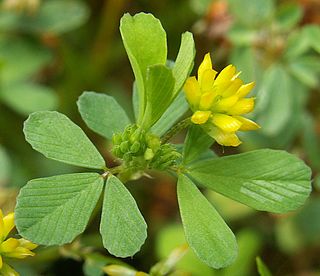
Trifolium dubium, the lesser trefoil, suckling clover, little hop clover or lesser hop trefoil, is a flowering plant in the pea and clover family Fabaceae. This species is generally accepted as the primary plant to represent the traditional Irish shamrock.

Medicago arabica, the spotted medick, spotted burclover, heart clover, is a flowering plant in the pea and bean family Fabaceae. It is native to the Mediterranean basin but is found throughout the world, usually on clifftop grasslands and grassy places. It forms a symbiotic relationship with the bacterium Sinorhizobium medicae, which is capable of nitrogen fixation.
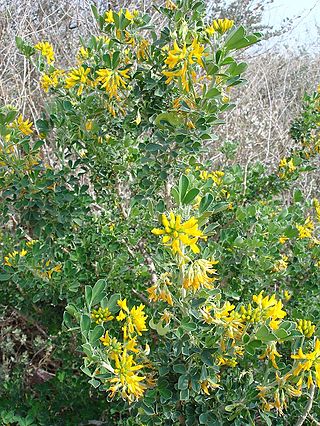
Medicago arborea is a flowering plant species in the pea and bean family Fabaceae. Common names include moon trefoil, shrub medick, alfalfa arborea, and tree medick. It is found throughout Europe and especially in the Mediterranean basin, primarily on rocky shores among shrubby vegetation. It forms a symbiotic relationship with the bacterium Sinorhizobium meliloti, which is capable of nitrogen fixation. It is the only member of the genus Medicago which is used as an ornamental. M. arborea is sometimes misidentified as Cytisus, which it resembles.
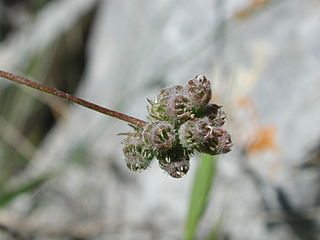
Medicago coronata, the crown medick, is a plant species of the genus Medicago. It is found throughout the Mediterranean basin. It forms a symbiotic relationship with the bacterium Sinorhizobium meliloti, which is capable of nitrogen fixation.
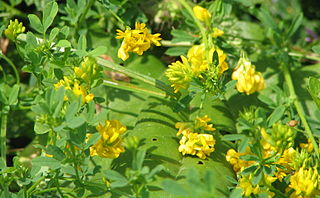
Medicago falcata is a plant species of the genus Medicago. It is native to much of Europe and Asia, but is found throughout the world. It forms a symbiotic relationship with the bacterium Sinorhizobium meliloti, which is capable of nitrogen fixation. Its common names include yellow lucerne, sickle alfalfa, yellow-flowered alfalfa, yellow alfalfa, sickle medick and yellow medick.
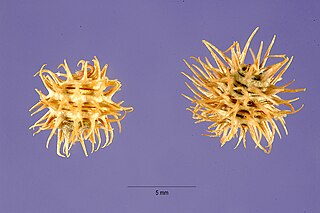
Medicago laciniata is a plant species of the genus Medicago. It is found primarily in the southern Mediterranean basin. It forms a symbiotic relationship with the bacterium Sinorhizobium meliloti, which is capable of nitrogen fixation. Common names include cutleaf medick and tattered medick. Grows in Sinai, Egypt.

Medicago littoralis is a plant species of the genus Medicago. It is found primarily in the Mediterranean basin. It forms a symbiotic relationship with the bacterium Sinorhizobium meliloti, which is capable of nitrogen fixation. Common names include shore medick, water medick, coastal medick, and strand medick.

Medicago marina is a plant species of the genus Medicago. It is native to the Mediterranean basin but is found worldwide. It forms a symbiotic relationship with the bacterium Sinorhizobium meliloti, which is capable of nitrogen fixation. Common names include coastal medick and sea medick.

Medicago minima is a plant species of the genus Medicago. It is native to the Mediterranean basin but is found worldwide. It forms a symbiotic relationship with the bacterium Sinorhizobium meliloti, which is capable of nitrogen fixation. Common names include bur medick, little bur-clover, little bur medick, little medick, small medick, and woolly bur medick.
Medicago murex, the spiny medick, is a plant species of the genus Medicago. It is found throughout the Mediterranean basin. It forms a symbiotic relationship with the bacterium Sinorhizobium medicae, which is capable of nitrogen fixation.

Medicago orbicularis is a plant species found throughout the Mediterranean basin and along the European Black Sea coast. It forms a symbiotic relationship with the bacterium Sinorhizobium medicae, which is capable of nitrogen fixation. Common names include blackdisk medick, button clover, button medick, and round-fruited medick.

Medicago praecox, the Mediterranean medick or early medick, is a plant species of the genus Medicago. It is found throughout the northern Mediterranean. It forms a symbiotic relationship with the bacterium Sinorhizobium meliloti, which is capable of nitrogen fixation.

Medicago scutellata is a plant species of the genus Medicago. It is found throughout the Mediterranean basin. It forms a symbiotic relationship with the bacterium Sinorhizobium meliloti, which is capable of nitrogen fixation. Common names include snail medick and shield medick.
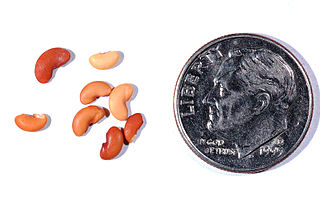
Medicago doliata is a species of annual herb in the family Fabaceae. They have a self-supporting growth form and compound, broad leaves.

Medicago monspeliaca, the hairy medick, is a species of annual herb in the family Fabaceae. They have a self-supporting growth form and compound, broad leaves. Individuals can grow to 0.12 m.
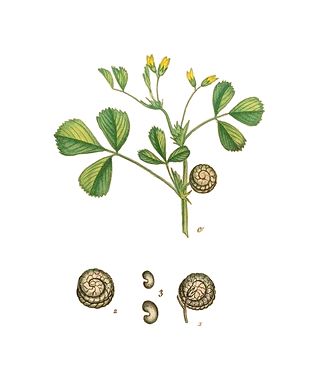
Medicago rugosa, the wrinkled medick, is a species of annual herb in the family Fabaceae. They have a self-supporting growth form and compound, broad leaves. Individuals can grow to 0.2 m.



















